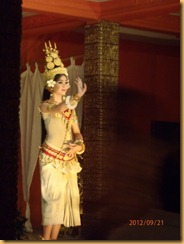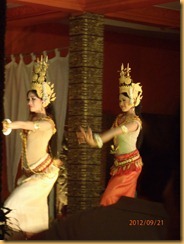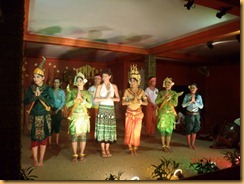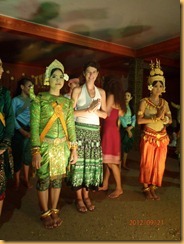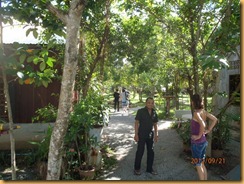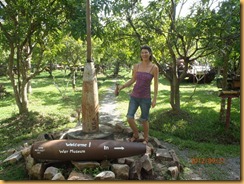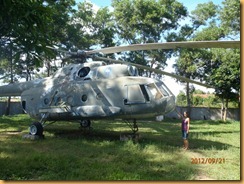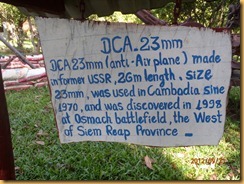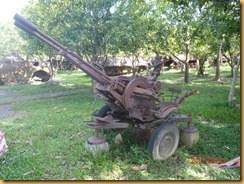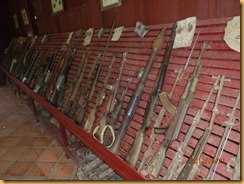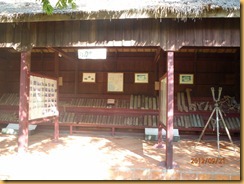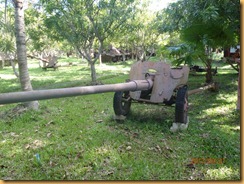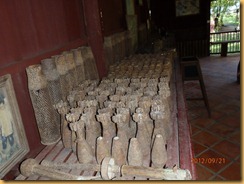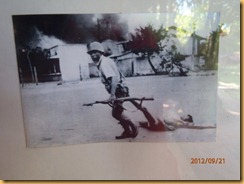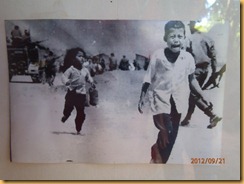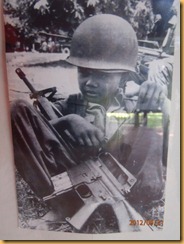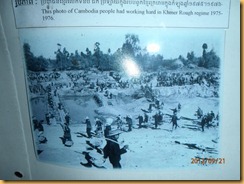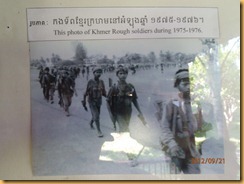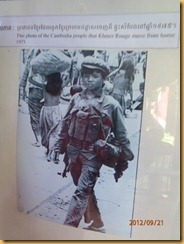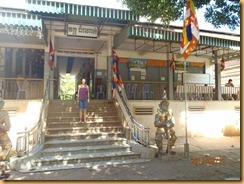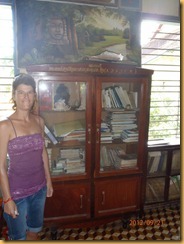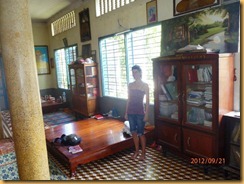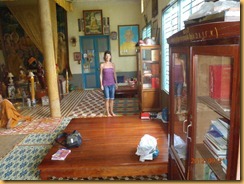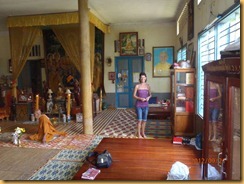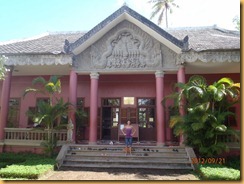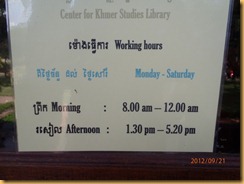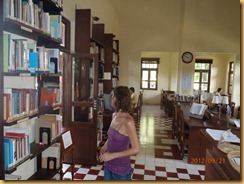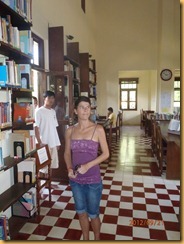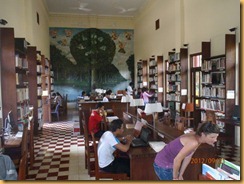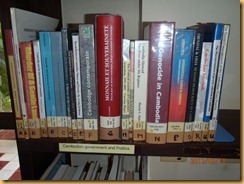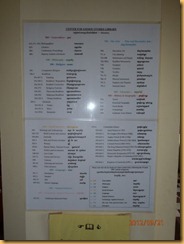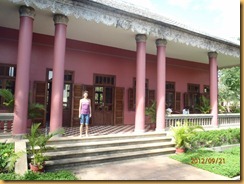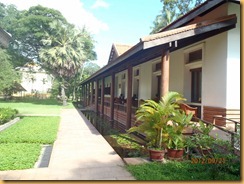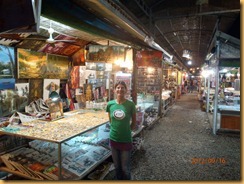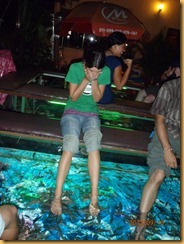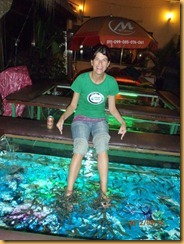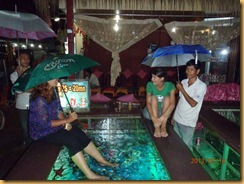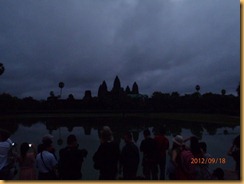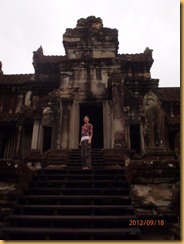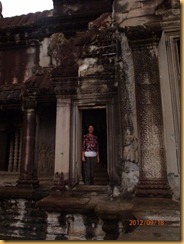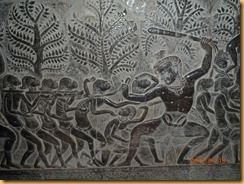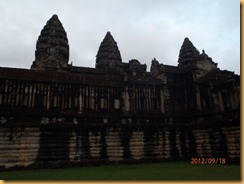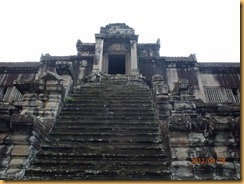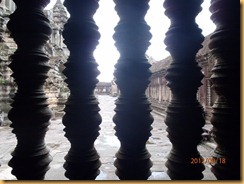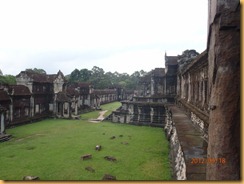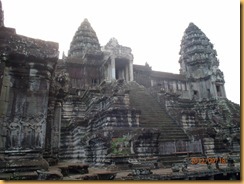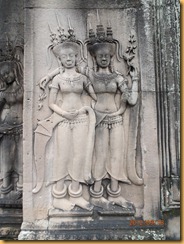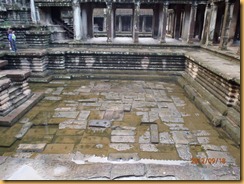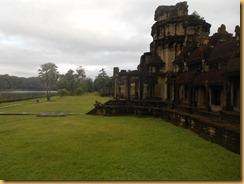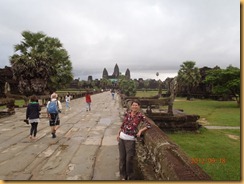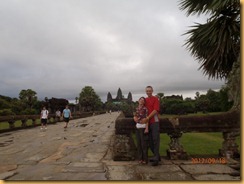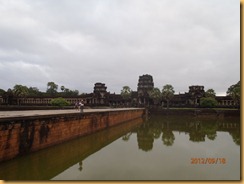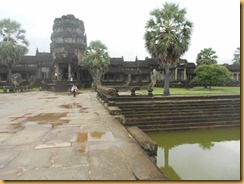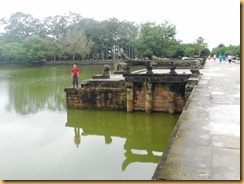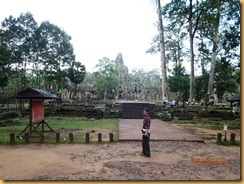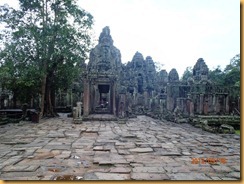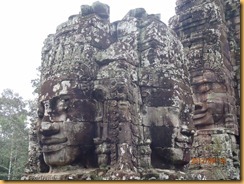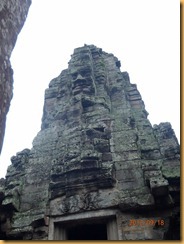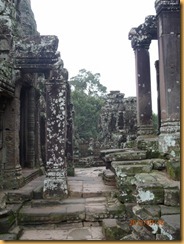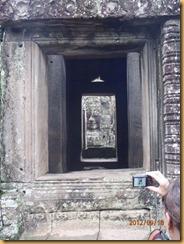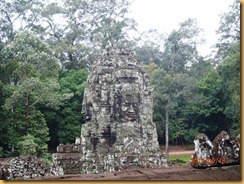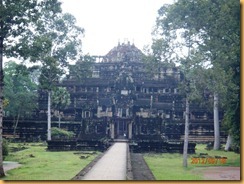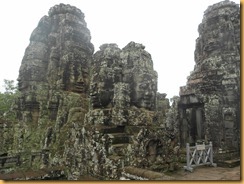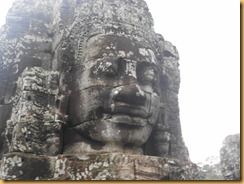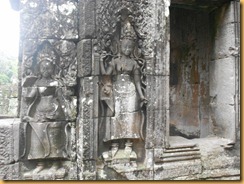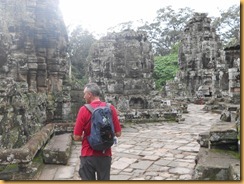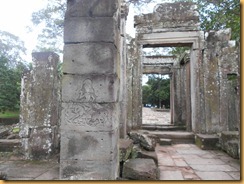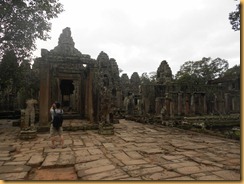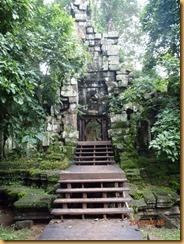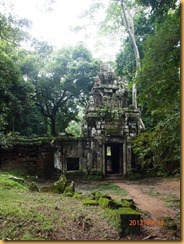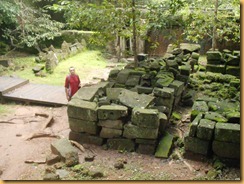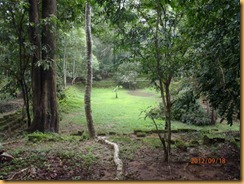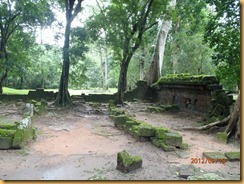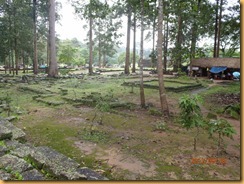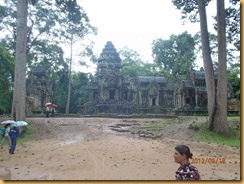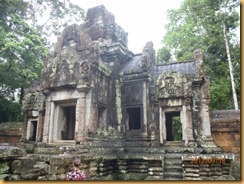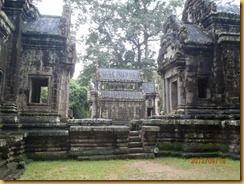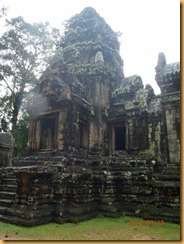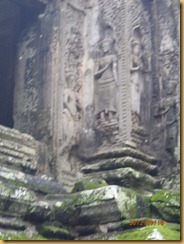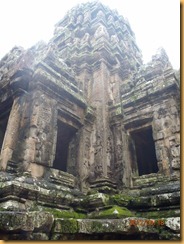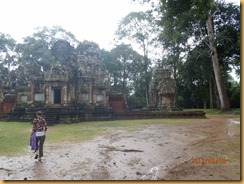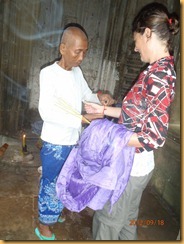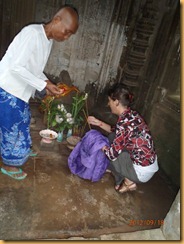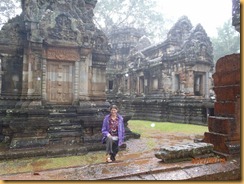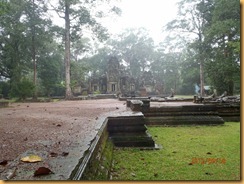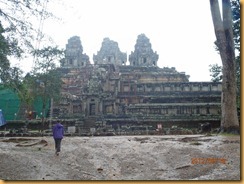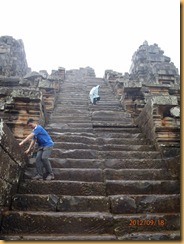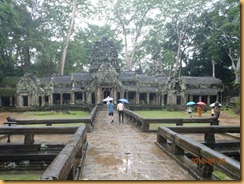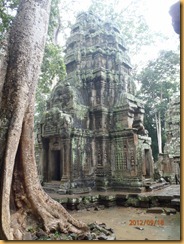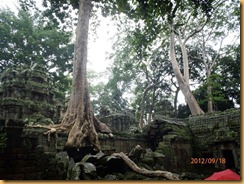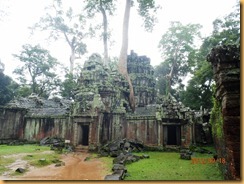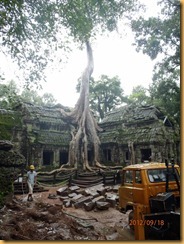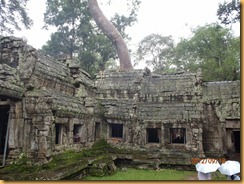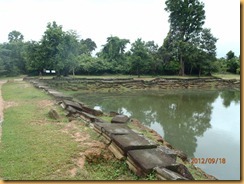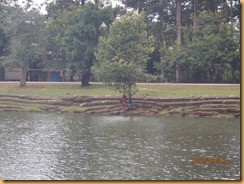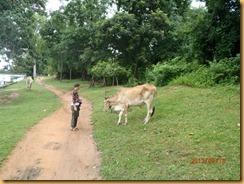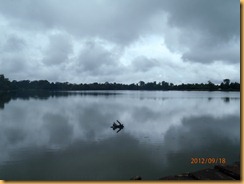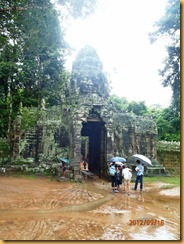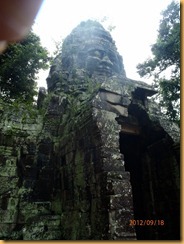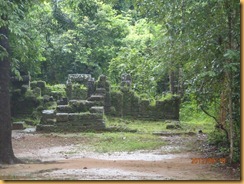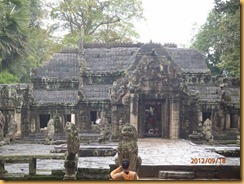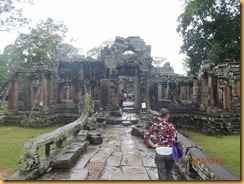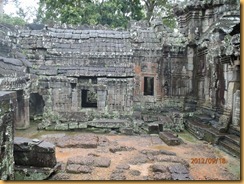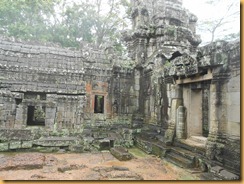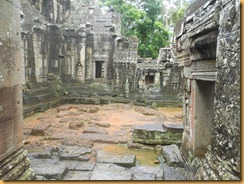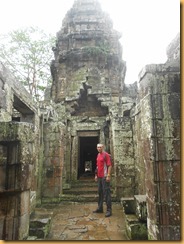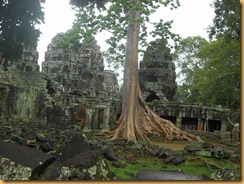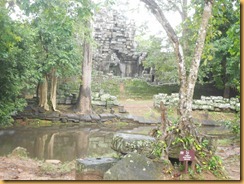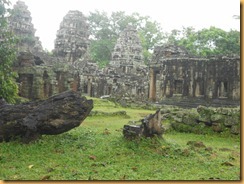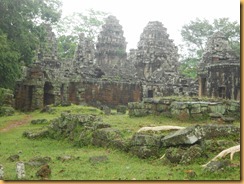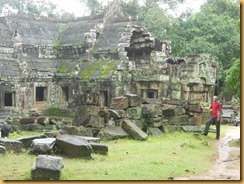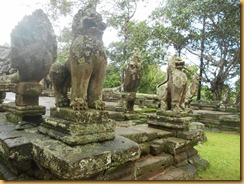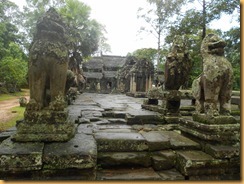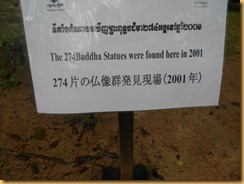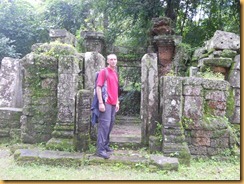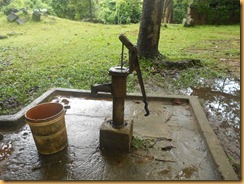Well, we made it to the 8th wonder of the world! The town is small but busy. First stop was the night market, the we thought we better get the famous fish massage, Andre was not keen, so I did it, it was like lots of kittens licking your feet! And your feet feel so smooth afterwards. I even convinced an American girl to have a go, as it was her last day in Cambodia, she asked me to sit there with her while she did it, it started raining but we soldiered on!
Angkor
Angkor ("Holy City") is a region of Cambodia that served as the seat of the Khmer Empire, which flourished from approximately the 9th to 15th centuries. The Angkorian period began in AD 802, when the Khmer Hindu monarch Jayavarman II declared himself a "universal monarch" and "god-king", until 1351. The temples of the Angkor area number over one thousand, ranging in scale from nondescript piles of brick rubble scattered through rice fields to the magnificent Angkor Wat, said to be the world's largest single religious monument.
Now for the temples………
Angkor Wat
is the largest Hindu temple complex in the world. The temple was built by King Suryavarman II in the early 12th century in Yasodharapura (now called Angkor), the capital of the Khmer Empire, as his state temple and eventual mausoleum. It has become a symbol of Cambodia, appearing on its national flag. Angkor Wat lies 5.5 kilometres (3.4 mi) north of Siem Reap and a short distance south and slightly east of the previous capital, which was centred at Baphuon. The outer wall 1024 by 802m and 4.5m high is surrounded by 30m of open ground then a 190m wide moat. The outer wall encloses a space of 820 000 square metres (203acres) At the ASEAN Tourism Forum 2012 both parties agreed Borobudur (Indonesia, see early posts as we have been there!) and Angkor Wat to be sister sites and provinces with 2 Indonesian airlines considering direct flights from Yogyakarta to Siem Reap!
We got to Angkor Wat after 5am to see the sunrise (of course there was no sunrise, but was still amazing to see the sun slowly illuminate the ancient city)
Angkor Thom – Bayon Temple
The Bayon was the last state temple to be built at Angkor, late 12th century, and the only Angkorian state temple to be built primarily dedicated to the Buddha. It stands at the centre of Jayavarman’s capital of Angkor Thom. Jayavarman VII did a huge amount of monumental construction and public works. The bit we found really different to other temples was the 216 gigantic faces on the towers, other constructions by Jayavarman VII also have the faces. It is also renown for bas-reliefs combining mythological, historical and mundane scenes.
Angkor Thom (“great city”)
It covers an area of 9 km², at the centre of the city is Jayavarman's state temple, the Bayon, with the other major sites to the north. The last temple known to have been constructed in Angkor Thom was dedicated in 1295. It was abandoned some time prior to 1609, when an early western visitor wrote of an uninhabited city, "as fantastic as the Atlantis of Plato" It is believed to have sustained a population of 80,000-150,000 people.
The south gate of Angkor Thom is 7.2 km north of Siem Reap, and 1.7 km north of the entrance to Angkor Wat. The city is surrounded by walls, 8 m high and 3km long with a moat surrounding the area of 9 km² and within the city was a system of canals. The main sites to see when wandering through this massive city are, Baphuon Temple. Royal Palace and Phimeanakas Temple, Elephant Terrrace, Leper King Terrace, Preah Palilay Temple, Tep Pranam Pagoda. It was confusing to walk through and know which parts you were seeing, even with a map!
Baphuon Temple
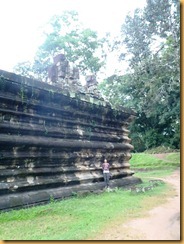 |
| Baphuon Temple |
|
 |
| Baphuon Temple |
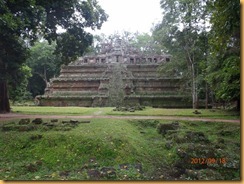 |
| Baphuon Temple |
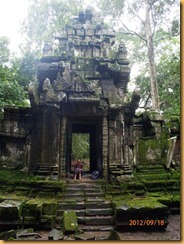 |
| Preah Palilay Temple |
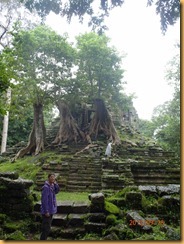 |
| Preah Palilay Temple |
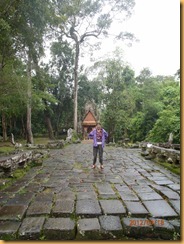 |
| Tep Pranam Pagoda |
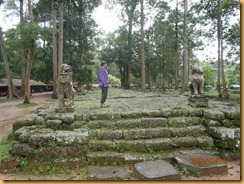 |
| Tep Pranam Pagoda |
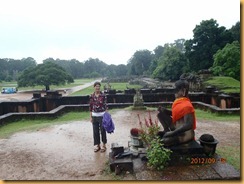 |
| Leper King Terrace |
 |
| Leper King Terrace |
 |
| Elephant Terrace |
So that’s the end of the city of Angkor Thom, now for some more Angkor sites
Thommanon temple and Chausay Tevoda
Thommanon is one of a pair of Hindu temples built during the reign of either Jayavarman VI (1080 –1113 AD) or Suryavarman II (from 1113–1150 AD around the time when work on Angkor Wat was begun.) There are distinctive carvings of females, known as devatas which indicate that they were built during the reign of Jayavarman VI.
Chau Say Tevoda is directly south of Thommanon and was built in the mid-12th century, it is a Hindu temple in the Angkor Wat style.
Ta Keo Temple
Jayavarman V was ten year old when succeeded to his father, Rajendravarman, in 968. His early years of reign were rather turbulent and the court officials dominated the royal politics. When he was aged seventeen (in 975), he began the construction of his own state temple, whose modern name is Ta Keo, that was dedicated some time around 1000. It remains unfinished. Yogisvarapandita, a high priest who became minister of Suryavarman I and "received" the temple from him many years later, says in inscriptions that a lightning strike hit the unfinished building, an evil omen, so the works stopped. Actually the temple worked continuously as a cult center until the 13th century, and even Yogisvarapandita worshipped the shrines at the first levels of the temple.
It has five sanctuary towers arranged like the number 5 on a dice, built on the uppermost level of five-tier pyramid, surrounded by moat. It is considered an example of the Khleang style.
The four stairways that lead on the summit are continuous and very steep. The central tower reaches a height of 45 meters. The stairs went small and really really steep, Andre got to the top but i got vertigo three quarters of the way up!
Ta Prohm
Built in 1186 and originally called Rajavihara. It was founded by the Khmer King Jayavarman VII as a Mahayana Buddhist monastery and university. Unlike most Angkorian temples, Ta Prohm has been left in much the same condition in which it was found: the trees growing out of the temple and ruins surrounded by a jungle makes it quite eerie.
Jayavarman VII constructed Rajavihara in honor of his family. The temple's main image, representing Prajnaparamita, the personification of wisdom, was modelled on the king's mother. The northern and southern temples were dedicated to the king's guru and his elder brother.
Records show that the site was home to more than 12,500 people (including 18 high priests and 615 dancers), with an additional 80,000 souls in the surrounding villages.
Srah Srang
It was dug in the mid-10th century, by initiative of Kavindrarimathana, Buddhist minister of Rajendravarman II. It was later modified around the year 1200 by Jayavarman VII, and there is evidence of a cemetery nearby.
At present Srah Srang measures 700 by 350 m and is still partially flooded. It was "The royal bathing pool" and used by the King and his wives. As with other reservoirs, maybe there was a temple standing on an artificial island in the middle of it, as suggested by finding of a basement. The landing, opposite the entrance to Banteay Kdei (next lot of photos and last temple we visited) has steps that lead down to the water flanked by two guardian lions. Andre decided we would walk around it (which took quite a while!) and we met a lovely cow along the way.
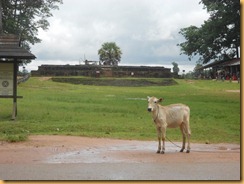 |
| The landing looking from Banteay Kdei |
Banteay Kdei
Banteay Kdei means "A Citadel of Chambers” and was built in the mid 12th to early 13th centuries AD during the reign of Jayavarman VII it is in the Bayon architectural style, similar in plan to Ta Prohm. It has been occupied by monks over various intervals until 1960’s.
Dad this photo is for you, a water pump!










